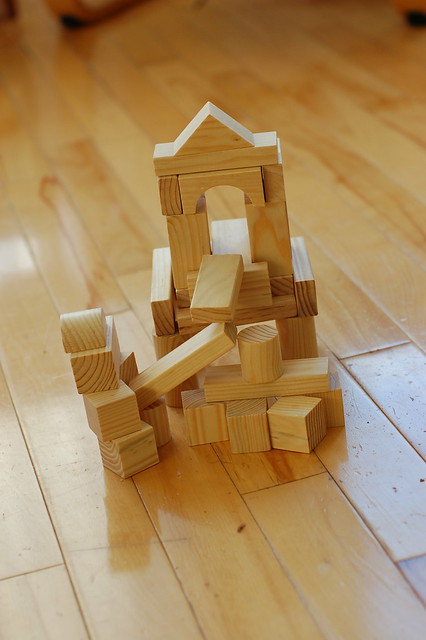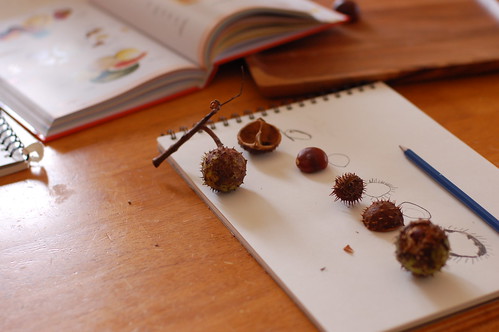A post on How we Montessori triggered a discussion about Reggio Emilia, and I thought the topic was interesting enough to share it widely.
After mentionning Reggio Emilia to her, she confessed that she was rather turned off by this because of the artistic aspect of it. And I could completely relate as I had a similar feeling at first.
I kept being pulled back to Reggio, but would always stop myself in my tracks at the mention of the "hundred language of children" which implied artistic activities.
I am a scientist, in my job and in my head. Art was not something that was promoted when I was a child. I have no problem letting my children explore art, contrarily to what my experience as a child was, but I don't feel like the best person to guide them through this since my limited experience and knowledge of arts. X is not a very artistic boy either. He is a very reality based child. He is very creative in what he does, but not in arts per se. How could Reggio work here?
But surprisingly, I have been able to find my niche in Reggio, or maybe what I do is Project based "homeshooling", (but truly, I do not think ones need to homeschool in order to incorporate that in their lives), it does not matter, I do not want to get stuck in semantics here.
What I didn't understand is 100 languages of children doesn't have to be limited to art. You can find your own definition of a language, as long as somebody can express what they are learning, in a manner they are comfortable to.
One of the principle that I have always adhered to, coming from Montessori, was the idea of following the child. She said that the child is not an empty vessel in which we could pour knowledge, but rather an individual that can and know what he needs to build himself. Letting him choose his experiences, and letting him be intimate with those is important for him to grow. Reggio allows just that, following the interest of the child, just not in a set environment, with specific material.
Reggio states that the child should be able to work in an area of interest for the amount of time he wants, with the means that speaks to him, without being directed or lured to learning a specific set of knowledge. Choosing an interest and building on it as long as the child can, as long as his interest flourish within that topic, and let oneself go with the flow along other interests that are somehow connected. That is what Reggio is about. The beginning of a project includes brainstorming, new ideas that needs to be developed, tried and improved. It means discussions and reading have to take place to get ready, ideas have to be shared analyzed, fine tuned and even documented... so many skills that are very welcome in life.
The child should be able to revisit his work and even start it over again, and this should not be seen as a waste of time, but rather as adding another layer of knowledge, a new experiment of the previous work, seen with new eyes, and with more experience this time. The child is able to choose what he needs to learn and how to learn it following his own interior"plan"and we should trust this blueprint of construction. This does not mean that the child should not be guided though, and guidance can be an asset to the child's learning.
Feels a lot like Montessori Cosmic Education to me, with an emphasis on expression.
Montessori insisted upon the importance of attention, letting the child have the space and time to develop this. This is nurtured and sustained by letting the child live in his project at his own pace.
So really, with this angle, I am not surprised Reggio was appealing to me, it feels so close to Montessori.
So now, how about the expression part?
I think there is more to painting and modeling for expressive means.
X is a builder. He loves mechanics. The down to earth kid.
When he is pursuing a topic, he looks at books, looks at images and study them. He regularly ask me to make photocopies of these images and he pins them to his board.
He study these images and he learns the vocabulary that is associated to it. I have even seen him identifying part of these drawings.
More often then not, he tries to build something that is associated with the topic, often with success, sometimes not.
In this project about space, he looked at launch pads that he recreated with blocks for block play later during the day. I even saw him try to make a astronaut suit to be used in prop play.
 |
| photo taken by X and used as an inspiration to make an astronaut suit |
Recently, he has been interested in becoming better at drawing. I don't think his art experience will go any further then this. But I agree that a minimal knowledge of drawing and sketching is an asset, even to a scientist. He sketched rockets and space shuttles, designing new features on them. He talked to us extensively about those drawing, explaining what parts does what.
And don't get me started on LEGOs. We have many weeks of rocket building with LEGOs. I think this is a mean of expression that is just as valuable then painting.
Photographs are also a big part of X documenting his work. He loves to photograph what he does and have the pictures printed. I am sure that he is about to go to another level in photography and try photo montages and such.
 |
| Photograph taken by X at one of the space museum. He was interested, no, fascinated by the mechanics of the reactors |
Other things possible are the launch of a blog, newsletters, whether written or with images only, making a lecture to member of the family or friends, making an exposition of photograph taken, or a book maybe or even a video...I think the possibilities are endless, if we can get out of the art (painting, modeling...) box.
This space topic has been on for months now. He has learn a lot through it, and not only about space. About vocabulary, about weather, about geography, about launch pads, famous astronauts, moon exploration and so on. And I see that it is about to shift. The topic of telescopes is the turning point. He has been getting a wider interest in using the tools for observations: magnifying glass, binoculars...and most of all how they work. I don't know where this will settle, but I will be curious to know.
These are the reasons we chose to incorporate Reggio in our house. We feel as parents, that the importance of being the director of your life and of your learning is one that cannot be understated. We truly believe in the capacity of the child to build himself and the need, as parent, to guide them without directing them. I have seen X do things he would never had done if it would have been part of an imposed project. And I think that the learning not only takes place on the topic the child is researching, but also at meta level: learning about learning, which curiously, is not a topic taught in many school around here, and yet is one that is necessary in life.
To close this post, I would like to link to a video that I found while researching rocket projects for X. I really loved looking at it, but X was truly inspired by it, by wanting to retouch his ideas, try something else, and revisit ideas he had but didn't think would work.
We both loved how Reggio and Montessori were co living in the learning experience. I have to admit that is has influenced how we are going about homeschooling here. Note that the project is mainly construction based, there is not a lot of art, drawing being put aside, during the construction of this. I hope you will enjoy it as much as we did!
If you are interested in Reggio or project based homeschooling, I strongly suggest Lori's book Project Based Homeschooling, which was the book I needed to make the plunge and most importantly, have a better understanding of this.




This was a very interesting post. Thanks for sharing.
ReplyDeletelove this post. many people get hung up on the “art” aspect of reggio (and, by extension, project-based homeschooling), not understanding that the hundred languages comprise *all* of the ways a child can express and represent what he knows and what he wants to know. you have stated it beautifully here.
ReplyDeletebefore children can read and write independently, they can draw, paint, sculpt, model, dance, sing, tell stories, act, and build (and communicate in dozens of other “languages”) in order to communicate with others and express themselves. and after children master reading and writing, these other languages give their explorations and their sharing added depth and dimension.
besides mastering the subject area or idea they are exploring, they are mastering the skills these languages require as well as the underlying mechanics of how we learn — so, three layers of learning.
and finally, the tremendous variety of languages is inclusive to all children, regardless of talent and temperament. the painters, the storytellers, the builders, the planners — they all have a place, and all of their contributions are necessary and valued.
thank you so much for endorsing my book! :)
coming back to add...
ReplyDelete“I think the possibilities are endless, if we can get out of the art (painting, modeling...) box.” — the (authentic) art box is a very BIG box that includes his trying to make an astronaut suit and making a launch pad out of blocks (modeling!). redefining what art is, what it does, and what it can be should be part of the process.
Thanks Lori for your comment!
ReplyDeleteI agree with your last comment, but I have just come to see it this way. And I think it takes a while before we can see it this way. Before I was trapped in the basic art. My box has gotten bigger over time, and I now understand that yes, building is a form of art but at first, I didn't see it this way. My art box was a lot smaller.
Thanks Kylie, and thanks for the discussion your post triggered